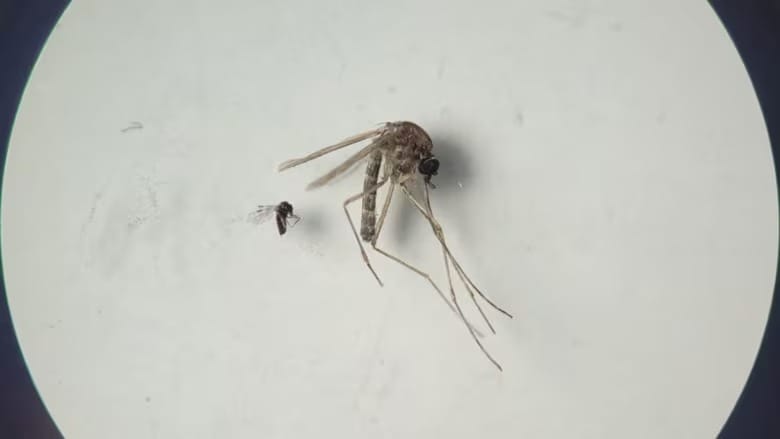A virus spread by tiny insects is on the rise in Brazil and Cuba. Here's how to protect yourself
People move virus north beyond its traditional niche in Amazon

Canadians heading to popular destinations like Cuba are being advised to take precautions against insects that transmit the rare and potentially deadly Oropouche virus, also known as Oropouche fever.
This week, U.S. officials reported 21 cases of Oropouche virus disease among travelers returning from Cuba as of August 16. Most of these individuals recovered without medical treatment, though three required hospitalization.
The virus is primarily spread through bites from certain types of midges and mosquitoes that are not found in Canada.
Canadian doctors are being advised to monitor for infections in returning travelers. While Oropouche virus disease has historically circulated in Central and South America as well as the Caribbean, this year has seen an unexpected rise in cases, with new infections reported in areas of Brazil, Bolivia, and Cuba where the virus had not previously been detected.
The impact of the virus on fetal health is not well understood, so precautions are recommended during pregnancy.

"It's generally been reported as relatively mild historically, but emerging data about neurologic complications and even fatalities means it needs to be monitored closely," said Dr. Zain Chagla, an infectious disease physician and associate professor of medicine at McMaster University, who has training in tropical medicine.
"Canadians travel to these regions, and even though there's no local circulation [in mosquitoes] here, it still necessitates monitoring for such cases upon their return," Chagla added.
Here's what you need to know about the illness that has prompted updated travel health advisories in Canada, the U.S., and Europe.
What is Oropouche Virus?
Oropouche virus is endemic in forested tropical regions. First identified in 1955 on Trinidad, it is named after a nearby village and wetlands.
It has sometimes been referred to as sloth fever because it was initially detected in Brazil from a blood sample taken from a sloth.
How Does it Spread?
The Oropouche virus is mainly transmitted through the bite of tiny flies known as midges, often called "no-see-ums," as well as some mosquitoes.
"Although the species of midge (Culicoides paraensis) and mosquito (Culex quinquefasciatus) that transmit Oropouche virus are not known to be established in Canada, they have been found in the United States," the Public Health Agency of Canada (PHAC) said in a statement to CBC News.
High temperatures, humidity, and seasonal factors influence midge populations.
Human-to-human transmission has not been documented.
What Are the Symptoms?
Symptoms of Oropouche virus are similar to those of other tropical diseases like dengue fever and the Zika virus, which gained attention in 2015 due to a large outbreak in Brazil linked to microcephaly, a condition where a baby's brain is underdeveloped.
"Symptoms include sudden fever, headache resistant to many treatments, muscle pain, and joint pain," said Andrea Vicari, head of the Pan American Health Organization’s (PAHO) unit for pandemic preparedness and response.
"It can be quite painful but is usually self-limiting."

Other symptoms may include light sensitivity, dizziness, pain behind the eyes, nausea, vomiting, and rashes, according to the U.S. Centers for Disease Control and Prevention (CDC).
Symptoms generally last less than a week but can recur days or weeks later, with most individuals recovering within days to a month.
"Oropouche fever can be mistaken for dengue," Canada's travel health notice cautioned.
How Severe is it?
About 60 percent of people infected with Oropouche virus show symptoms, the CDC reported.
The CDC estimates that one in 20 patients may experience more severe symptoms, such as bleeding and brain inflammation, including meningitis and encephalitis.
In July, Brazilian health officials reported two deaths of otherwise healthy non-pregnant women due to the infection, marking the first fatal cases in Brazil and the Americas region.
As of July 20, the World Health Organization (WHO) had recorded more than 8,000 confirmed cases of Oropouche virus this year, with over 7,200 in Brazil, along with cases in Bolivia, Peru, Colombia, and Cuba.
Brazilian authorities also reported five cases in pregnant individuals, with evidence of fetal transmission resulting in outcomes such as fetal death or birth abnormalities, including microcephaly.
"Until more evidence is available, pregnant individuals traveling to affected areas are advised to follow strict bug bite prevention measures," a PHAC spokesperson advised.
"Pregnant travelers should discuss their travel plans with their healthcare provider and seek medical attention if they feel unwell after their trip."
How is it Treated and Prevented?
There are no vaccines or specific treatments for Oropouche virus.
The best prevention is avoiding insect bites. Travelers are advised to consult a healthcare provider or visit a travel health clinic, ideally at least six weeks before departure, for personalized advice.
During travel, individuals should:
- Use approved insect repellent on exposed skin, following all label directions.
- Limit outdoor activities during peak midge and mosquito activity times.
- Wear light-colored, loose-fitting clothing made of tightly woven materials, such as nylon or polyester. Long pants, long-sleeved shirts, closed-toe shoes or boots, and a hat are recommended.
- Use mosquito netting when sleeping outdoors or in inadequately enclosed buildings.
- Consider wearing insecticide-treated clothing.
What's Next?
U.S. and Canadian officials are working to enhance rapid detection and surveillance of the virus to guide public health prevention measures.
Suspected Oropouche virus cases from provincial and territorial laboratories will be sent to PHAC's National Microbiology Laboratory in Winnipeg for confirmatory testing.





